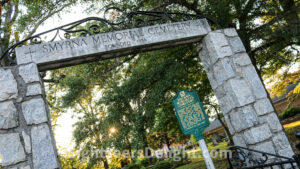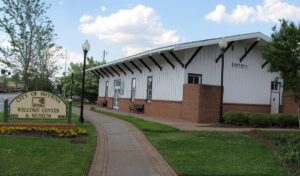According to various sources, Smyrna Methodist Church founded the Smyrna Memorial Cemetery in 1838 near what is today the intersection of Memorial Place and Atlanta Road in the heart of the city. The 170-year-old cemetery lies in the shadows of Smyrna Market Village. The cemetery is home to a number of notable denizens of Smyrna over the years, including John Moore, who served the first mayor of Smyrna when the city was incorporated on Aug. 23, 1872. There are a total of 638 people buried in Smyrna Memorial Cemetery, but only about 238 graves are marked with headstones. The grave of Elijah Fleming, who died on April 8, 1848, is the earliest marked grave in the cemetery. The grave of his daughter, Mary, who died on March 14, 1858, at the age of 17, is the second oldest marked grave in the cemetery. A 1999 archaeological survey located 395 graves that were previously lost to history.
30080
Since it officially opened on April 25, 1999, the Smyrna Museum has dedicated to keeping alive the stories that make the Jonquil City unique — from images of the city’s past to artifacts from important events in history.
Located in a replica of the city’s railroad depot that was build in 1910 and razed in 1959, the museum is home to thousands of photographs, a number of exhibits and other displays, the museum is also home to a number of genealogical research materials.
While admission is free, the museum, which is operated by volunteers, does accept donations.
30080
Taylor-Brawner Park sits on what was once the Brawner Hospital complex. Following a 2005 Parks Bond, the city of Smyrna removed dilapidated buildings and developed a 10-acre park, which today includes a gazebo, two picnic pavilions, walking trail, amphitheater, playground, and open space. The park is also home to a pair of historic buildings: Brawner Hall and the Taylor-Brawner House.
30080
The Pace House in Vinings, Georgia, dates to after the Civil War. Before the war, Hardy Pace, operator of Pace’s Ferry, built his home in what was then called Vining’s Station. Federal troops, pursuing Confederate forces as they abandoned Smyrna, occupied Vining’s Station from July 5-17, 1864. Union Gen. William T. Sherman used Pace’s house as his headquarters and planned the siege of Atlanta. After federal troops left Vinings, the house served as a hospital for wounded soldiers during the Atlanta fighting, but because it was infected with disease, it was burned to the ground. Following the Civil War, Solomon Pace, Hardy Pace’s son, returned to find the homestead in ruins. Sometime between 1865 and 1874, he built a new home here, using whatever could be salvaged.
30339
In response to growing suburban sprawl in the mid-1980s, Smyrna’s mayor and City Council opted to rebuild the downtown area to create a family-friendly environment and community gathering space. This led to Smyrna’s “Village Green,” which includes a library, community center, private housing, retail and office space, a public safety facility and a 22,000-square-foot City Hall.
30080





